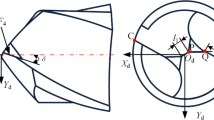Abstract
Prevention of deviation during deep hole drilling is a universal problem. This paper proposes a principle for elimination or reduction of deep hole drill deviation using cutting fluid. The principle is based on hydraulic locking, which is caused by fluid pressure. We developed a deep hole drill with a positive taper. The proposed deep hole drill comprises a tip, a shank and a taper, or a self-centering part (SCP) with a taper; existing drills, in contrast, do not contain tapers. On the proposed drill, the taper or SCP is set between and attached to both the tip and the shank. When the taper deviates during deep hole machining, a lateral force F is created in the radial direction. F will eliminate or reduce the deviation or eccentricity value automatically, ensuring that the taper and the deep hole maintain the same axis, keep the taper, tip, and shank moving along the axis of the machined deep hole, and improve the deep hole quality. A formula for calculating the lateral force is provided and is then proven. Experiments showed that the deep hole straightness quality was higher when drilled using the deep hole drill with the taper. We conclude that the deep hole straightness improvement results from the lateral force F produced by the taper. F is found to vary with taper length and diameter, and the taper design is introduced. The proposed technique is easy to implement with low cost and is promising for widespread application.
Similar content being viewed by others
References
Thil J, Haddag B, Nouari M, Barlier C, Papillon L (2013) Experimental and analytical analyses of the cutting process in the deep hole drilling with BTA (boring trepanning association) system. Mech Ind 14(6):413–429
Swinehart HJ (1967) Gundrilling, trepanning and deep hole machining. American Society of Tool and Manufacturing Engineers, Dearborn, Michigan, pp. vi–2
Biermann D, Kersting M, Kessler N (2009) Process adapted structure optimization of deep hole drilling tools. CIRP Ann Manuf Technol 58:89–92
Matsuzaki K, Ryu T, Sueoka A, Tsukamoto K (2015) Theoretical and experimental study on rifling mark generating phenomena in BTA deep. International Journal of Machine Tools & Manufacture 88:194–205
Al-Ata M, Hayajneh MT (2009) An investigation of bell mouthing in precision hole machining with self-piloting tools. Int J Adv Manuf Technol 43:22–32
botek™ USA (2016) System BTA drills. http://www.botekusa.com/bta/index.html. Accessed 16 March 2008
Kong LF, Li Y, Lv YJ, Wang QF (2013) Numerical investigation on dynamic characteristics of drilling shaft in deep hole drilling influenced by minimal quantity lubrication. Nonlinear Dyn 74:943–955
Sandvik (2016) Deep hole machining drills. http://www.sandvik.coromant.com/en-gb/products/Pages/deep-hole-machining-drills.aspx. Accessed 16 March 2008
Chin JH, Sheu SD (2007) Strengths and weaknesses of finite element modeling deep, hole drilling as compared with beam and column equations. Int J Adv Manuf Technol 32:229–237
Messaoud A, Weihs C (2009) Monitoring a deep hole drilling process by nonlinear time series modeling. J Sound Vib 321:620–630
Kong LF, Li Y, Lu YJ, Li DX (2009) Complex nonlinear behaviors of drilling shaft system in boring and trepanning association deep hole drilling. Int J Adv Manuf Technol 45:211–218
Kong LF, Chin JH, Li Y, Lu YJ, Li PY (2014) Targeted suppression of vibration in deep hole drilling using magneto-rheological fluid damper. J Mater Process Technol 214(11):2617–2626
Katsuki A, Onikura H, Sajima T, Mohri A, Moriyama T, Hamano Y, Murakami H (2011) Development of a practical high-performance laser-guided deep-hole boring tool: improvement in guiding strategy. Precis Eng 35:221–227
Hessey MF, Martin BP, Brighton DK (1969) Hydraulic lock forces on tapered pistons. [J]. ARCHIVE Proceedings of the Institution of Mechanical Engineers 184(53):983–992
Urata E (2012) Lateral forces on tapered pistons – an overview. Proceedings Of The Institution Of Mechanical Engineers Part C-Journal Of Mechanical Engineering Science 227(5):961–979
White FM (2004) Fluid mechanics, 5th edn. The McGraw-Hill Education(Asia) Co. and Tsinghua University press, Beijing, pp. 22–25
Author information
Authors and Affiliations
Corresponding author
Rights and permissions
About this article
Cite this article
Yu, D. Deep hole drill with positive taper and principle for elimination of drill deviation using cutting fluid. Int J Adv Manuf Technol 89, 3195–3206 (2017). https://doi.org/10.1007/s00170-016-9269-x
Received:
Accepted:
Published:
Issue Date:
DOI: https://doi.org/10.1007/s00170-016-9269-x



